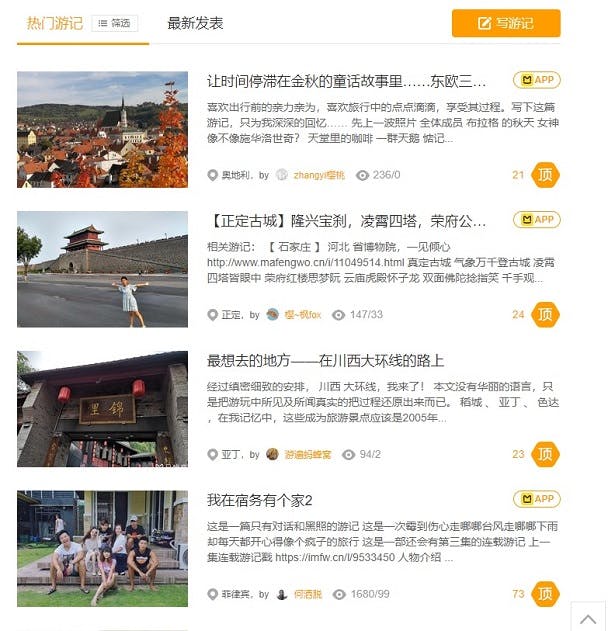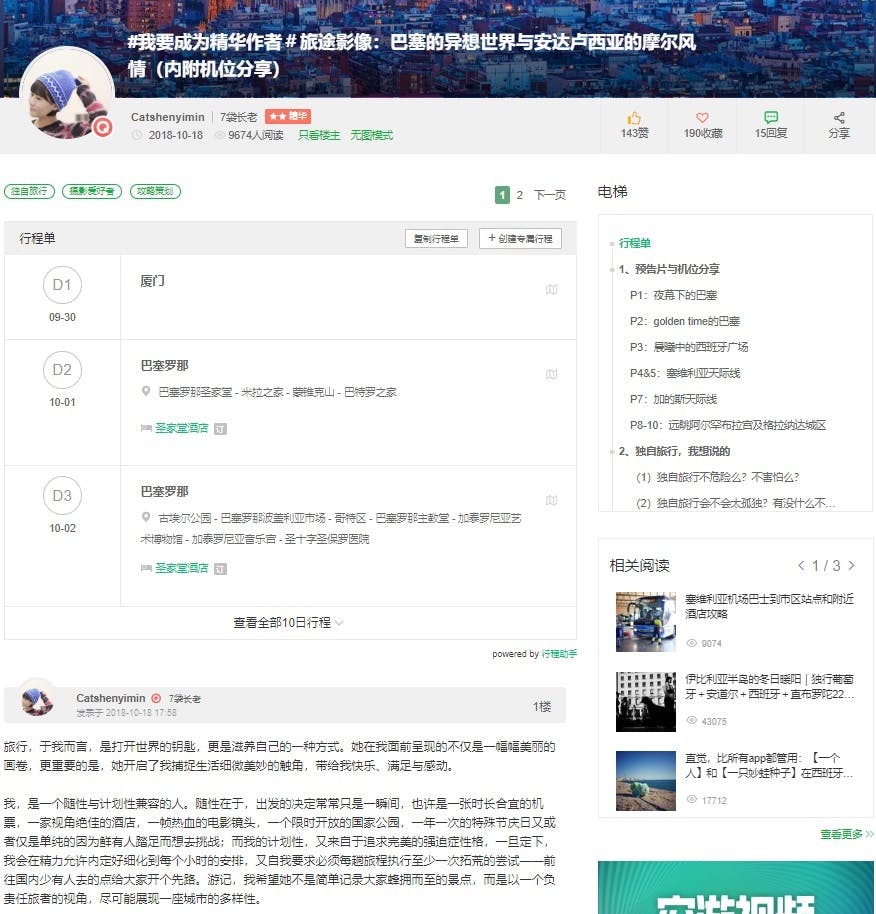China’s travel industry is no exception, with young travellers increasingly opting to travel alone (rather than in groups as older generations have typically done) and plan their own trips, looking to content from influential travel bloggers for advice and inspiration.
However, instead of posting to Instagram (or rather to Chinese social platforms like Weibo and WeChat), many of China’s travel influencers are publishing and building followings directly on online travel agencies, or OTAs.
Travel websites like Mafengwo (马蜂窝) and Qyer (穷游网) have achieved huge popularity by encouraging users to publish in-depth accounts of their travel experiences. Both websites see thousands of blogs uploaded on a daily basis, which link seamlessly in with other resources such as downloadable travel guides, discussion forums, and purchasing and booking functions.
Both sites were founded in the mid-2000s, but have recently attracted increased attention thanks to successful Series D funding rounds which raised millions of dollars’ worth of investment from major players like Chinese tech giant Alibaba and Singaporean wealth fund manager Temasek.
How have China’s OTAs succeeded by incorporating user-generated content into their platforms, and become a hub for influencers in the process? And the all-important question: can other travel websites benefit by doing the same?

Blogs and travel offers sit side-by-side on the travel website Qyer
Chinese bloggers and the desire for in-depth content
First off, one factor that may well be relevant to the huge success of bloggers publishing to these platforms is the particular popularity of in-depth content among Chinese internet audiences. If you research influencer marketing in China, you’ll come across as many references to “bloggers” as to “influencers” and “KOLs” (Key Opinion Leaders).
Influencer marketing in China seems to go hand-in-hand with in-depth, written content in a way that it doesn’t in the west. While influencers in the west absolutely can be and are bloggers, there is a sense that we have been moving away from the age of the blogger towards the age of the visual and video-based influencer, the Instagram influencer and the YouTube star. (A case in point: Blogosphere magazine, a UK print magazine published about and for bloggers, recently shifted its branding to reference “influencers” rather than “bloggers”, changing the magazine’s tagline from “for bloggers by bloggers” to “the influencer industry”).
But in China, if anything, the trend is moving the other way. A recent article on China’s “KOL bubble” in the South China Morning Post asserted that the “next stage in the evolution of Chinese digital culture” is quality content, and that China’s young people are seeking it out due to a desire for insights that are in-depth and authentic:
“I spoke to many Chinese Millennials in Shanghai, where I live, and their interest is in the rise (or the return) of bloggers – those who are not KOLs, who are not paid to promote, but who create honest, frank content and opinions based on genuine passion. That is, not just someone who is posing with Photoshopped, elf-like facial features; but someone who has written thoughtfully, expressed interesting ideas, and put together short videos that amuse.”
China: Why digital marketing is changing along with a millennial middle class
This desire can be seen reflected in the popularity of new platforms like Xiaohongshu, whose unique selling point is its engaged community of shoppers who publish in-depth reviews of their luxury product purchases.
This goes some way towards explaining why so many Chinese travellers flock towards – and create – in-depth blog content about, or to inform, their travels. But how did online travel agencies become a publishing hub for this type of content?
How China’s OTAs have become a hub for influencers and user-generated content
Another distinctive characteristic of China’s internet landscape is that many apps and businesses, rather than offering one type of service or product, evolve into a “one-stop shop” for multiple related (and sometimes unrelated) products or services. There’s Xiaohongshu, which doubles as both a social community and a marketplace for luxury products; WeChat, which combines messaging, payments, and many other types of app into one platform; or Meituan Dianping, a “super-platform” for all kinds of services, from food delivery to hotel and hospitality services.
Chinese online travel agencies are no exception, combining a wide variety of travel planning resources with the ability to book trips – and a vibrant community of bloggers catering to the demand for in-depth travel accounts.
While many of China’s OTAs are known for having user-generated content and playing host to influencers, the best-known – with the most well-established social communities – are Mafengwo and Qyer.
Mafengwo
Mafengwo was originally launched in 2006 as a travel forum by frequent travellers Chen Gang and Lü Gang. Chen and Lü told China Daily in an interview in 2014 that they founded the site as a source of up-to-date travel information, as many printed guidebooks were out of date, and online travel information was scattered and disorganised.
Even in its early days, the site was filled with detailed accounts of travel experiences, often related over multiple posts by the same author.

An account of a trip to Canberra, Australia, posted to the Mafengwo forum in 2006
The site grew through word of mouth, and in 2011 Chen and Lü turned their part-time project into a full-time venture. In 2012, they integrated booking functions into the site through partnerships with companies like Booking.com, Agoda, Ctrip and eLong, making it possible for travellers to book the trips they were reading about and discussing.
Today Mafengwo has more than 100 million registered users, around 80% of whom access the site via the mobile app. Some 4,500 blogs are uploaded daily to the platform, and Mafengwo uses data mining and semantic analysis to identify the most valuable information to pull into its crowdsourced travel guides.
Users can like, comment, share and save one another’s posts on Mafengwo just as on social media. The site’s forum also lives on as a place for questions and answers about travel, and users can share their best photographs on Wengweng, an “Instagram-style” section for uploading images with geotags.
The site’s highly specialised and engaged audience make it an ideal platform for travel influencers to publish to and grow a following. Mafengwo’s most popular bloggers are known as Fengshou (蜂首) and their contributions are featured on the homepage of the site.

Travel blogs featured on Mafengwo’s homepage
Travel and hospitality companies can benefit immensely from growing a positive reputation on the site – in the same way that businesses benefit from positive online reviews – and can partner with KOLs to promote their services. In 2016, for example, Japanese ticket seller Pia arranged to have influential Mafengwo bloggers write about Japanese services and tourist spots in a bid to promote Japan as a destination to Chinese travellers.
Qyer
Like Mafengwo, Qyer (sometimes called Qiongyou) began life as a travel forum – specifically, a forum for Chinese overseas students to share their experiences, advice, and money-saving tips. It was founded in 2004 by Yi Xiao, a Chinese student who was living in Hamburg at the time.
Four years later, the website had attracted more domestic users than overseas, and so Yi moved back to China to run the website from his home country. It now has more than 88 million users publishing and consuming content related to overseas travel – while Mafengwo focuses mainly on domestic travel within China, Qyer caters chiefly to international travel, making the two platforms naturally complementary (albeit with some overlap).
In addition to its main mobile app, Qyer has a number of ‘spin-off’ apps dedicated to specific elements of travel planning, such as its Itinerary Assistant app, which works with Booking.com to enable users to make reservations and make bookings, which are then added to a detailed itinerary. Itineraries are also displayed above users’ blogs on Qyer, helping other would-be travellers to plan their trips.

A user’s travel itinerary, accompanied by their account of the trip, on Qyer
Thanks to its popularity as a site for international travellers, particularly young travellers, to share information and book trips, partnering with KOLs on Qyer is an excellent way for travel companies to promote their services.
The community can also be a valuable source of data: in 2016, destination consultancy Resonance data-mined reviews on Qyer in order to discover the most positively-reviewed overseas destinations among Chinese visitors, as well as the months they were most commonly visited, and the activities tourists enjoyed best.
Can other travel websites benefit by incorporating social features?
As I wrote at the very beginning of this piece, travel influencers and the content they publish play a huge role in helping inspire their followers to book similar trips and travel the world. Plenty of travel and hospitality companies have already carried out successful campaigns by partnering with influencers – could they benefit even more by hosting this kind of user-generated content on their own website?
Learn more
Both Qyer and Mafengwo began life as forum communities that later incorporated an ecommerce element, which is one way to build an engaged social community around travel, but not the only way. In fact, a recent case study from digital agency ValTech and airline easyJet showed how successful incorporating UGC into a travel website and creating “home-grown” influencers can be.
Speaking at Festival of Marketing 2018 in October, Lydia Livingston, Creative Director at ValTech, explained how the company had been brought on board by easyJet to revitalise its “Inspire Me” tool, a website feature originally created in 2013 for the purpose of inspiring website visitors to book a holiday.
The target customer group was young, tech-savvy Millennials who carry out travel research across multiple devices. Peer recommendations are much more important to them than formal travel websites – just like the millions of young Chinese travellers who frequent Mafengwo and Qyer – and “Instagrammable” holidays are the trip of choice. Thus, ValTech decided to create an experience that would inspire browsing customers to become “virtual tourists”, using conversation and user-generated content as the hook.
The agency designed a conversational user interface geared around a series of drop-down menus with informal language, which helped users feel at ease and more willing to volunteer information. However, what really made it work, in Livingston’s words, was the user-generated content.
easyJet’s brand and marketing team reached out to travellers for submissions, and were rewarded with hundreds of images from customers’ holidays, all unfiltered and unedited. These were accompanied by quotes, to add a level of peer recommendation, and helped to give a real sense of the destinations – bringing the “virtual tourist” idea to life.
 easyJet’s revamped “Inspire Me” tool
easyJet’s revamped “Inspire Me” tool
As a result of the initiative, easyJet gained more than 100 brand advocates who would share content on their accounts. After a few weeks, the team had already seen a 20-25% increase on progression from the Inspire Me tool to the flight grid, and an upsurge in final bookings.
Not every travel website can and should double as a social community or content platform. But it’s clear that there are unexplored possibilities that sites like Mafengwo and Qyer – and outside of China, easyJet – have proven can work, and they may be a valuable way of getting an edge in the competitive travel market through the power of influencers.
For more of the latest digital trends shaping the future of travel, download Econsultancy’s Digital Trends in the Travel and Hospitality Sectors report, produced in partnership with Adobe.


Very Lovely Info.